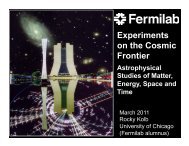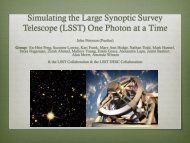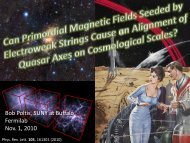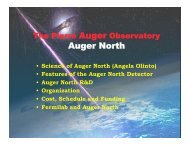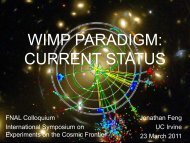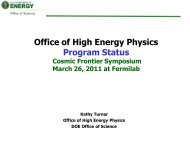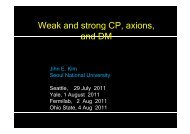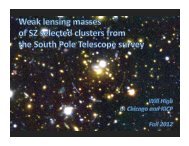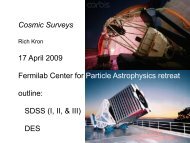Aaron Chou - Fermilab Center for Particle Astrophysics
Aaron Chou - Fermilab Center for Particle Astrophysics
Aaron Chou - Fermilab Center for Particle Astrophysics
Create successful ePaper yourself
Turn your PDF publications into a flip-book with our unique Google optimized e-Paper software.
<strong>Particle</strong> (Astro)Physics with Lasers<br />
<strong>Aaron</strong> <strong>Chou</strong><br />
FCPA retreat<br />
April 18, 2009
Axions, Strong CP and Dark Matter<br />
• The neutron electric dipole moment is measured to be
Shining Light Through a Wall<br />
K. Van Bibber, et. al., PRL 59, 759 (1987)<br />
Prob(ϒa) ≈ (gBL/2)<br />
Tabletop appearance experiment:<br />
Photons oscillate into axions, go through the wall, and oscillate back into photons.<br />
2<br />
Prob(ϒaϒ) ≈ (gBL/2) 4<br />
3
Laser<br />
box<br />
GammeV Photon Regeneration Apparatus<br />
GammeV was located on a test stand at<br />
<strong>Fermilab</strong>’s Magnet Test Facility. Two shifts/day<br />
of cryogenic operations were supported.<br />
Vacuum<br />
port<br />
Cryogenic<br />
magnet<br />
feed can<br />
Tevatron<br />
magnet<br />
Cryogenic<br />
magnet<br />
return can<br />
Cryogenic<br />
magnet<br />
return can<br />
PMT<br />
box<br />
Vacuum tube<br />
connected to<br />
plunger<br />
PMT<br />
box<br />
Lens PMT
GammeV limits on axion-like particles<br />
• From lack of excess above background, we derive 3σ<br />
exclusion regions and completely rule out the PVLAS<br />
axion-like particle interpretation by more than 5σ.<br />
Pseudoscalar Scalar<br />
PRL 100, 080402 (2008)<br />
5
Search <strong>for</strong> dark U(1) paraphotons<br />
• New low mass dark photons can mix with visible photons in our<br />
apparatus, without the need <strong>for</strong> a magnetic field. These dark gauge<br />
bosons are predicted generically in BSM theories and are perhaps<br />
implied by PAMELA/ATIC<br />
GammeV has the best limits <strong>for</strong> masses in the milli-eV “dark energy scale”
Axion limits<br />
GammeV has world’s best laboratory limit on the axion-photon<br />
coupling, but is not competitive with astrophysical limits.<br />
How can we do better?<br />
GammeV
Search <strong>for</strong> axions via resonant<br />
photon regeneration<br />
K. Van Bibber
New FNAL experiment to probe the<br />
10 -11 GeV -1 coupling scale<br />
• Sikivie/Tanner/van Bibber: resonantly-enhanced photon regeneration (PRL<br />
98:172002,2007), hep-ph/0701198<br />
Rate of photon-axion transitions is enhanced by a factor of the cavity finesse<br />
(F= ~10 5 ) on each side (resonant reconversion in the 2nd cavity)
Resonant Regeneration<br />
Cavity 1 recycles the laser beam. If the power transmission of the<br />
injection mirror is η, then the beam makes 1/η roundtrips on average.<br />
The instantaneous power passing through the magnetic field is amplified<br />
by a factor of 1/η.
Resonant Regeneration<br />
Cavity 2 captures the regenerated photon beam as a standing wave <strong>for</strong> 1/η<br />
roundtrips. If the two cavities are phase-locked, then the electric field of the<br />
standing wave builds up coherently over the cavity lifetime. The electric<br />
field is there<strong>for</strong>e enhanced by a factor of 1/η relative to that of a no-cavity<br />
configuration.<br />
This coherent build-up gives a factor of (1/η) 2 in the regenerated photon<br />
population since N≈E 2 .
Resonant Regeneration<br />
The regenerated standing wave is detected as it escapes the cavity through<br />
the far mirror. This escaping beam is attenuated by a factor of η relative to<br />
the photon flux bouncing around in the cavity.<br />
The total enhancement in the event rate is:<br />
(1/η)×(1/η) 2 ×η =(1/η) 2 = (F /π) 2
Phase-locking and heterodyne detection gives<br />
single-photon sensitivity
Resonant Regeneration baseline design<br />
Regeneration rate:<br />
g 10 = g/(10 -10 GeV -1 ), B 4 = B/(4 T), L 54 = L/(54 m) (9 magnets),<br />
F 5 = F/10 5 , P 10 = P/(10 W)<br />
100% CL discovery at g 10 =0.2 (3 events) in 30 days of continuous<br />
integration time if limited only by quantum zero-point background.<br />
Sensitivity scaling:
Potential sensitivity to photon coupling g<br />
Baseline design with<br />
BL=180 Tesla-meters,<br />
F=3 10 5 ,<br />
P=10W,<br />
Integration time T=30 days.<br />
Sensitivity g~10 -11 GeV -1 or<br />
better with improved finesse.<br />
Is the g=10 -11 GeV -1 coupling scale interesting?<br />
Yes! Axions are part of the hidden sector, which might be much richer than usually<br />
imagined (single WIMP + single QCD axion + nothing else).<br />
Nobody has ever looked in this coupling regime with a sensitive microscope<br />
be<strong>for</strong>e, and that alone is enough reason to build the experiment.
Another hint: Light shining through the universe<br />
Anomalous transparency of the universe to VHE and UHE gamma rays<br />
observed by HESS, VERITAS, MAGIC, Whipple, HiRes, can be explained<br />
by mixing of photons with axion-like particles<br />
Hooper, Serpico, 2007<br />
De Angelis, Mansutti, Roncadelli, 2007<br />
Simet, Hooper, Serpico, 2008<br />
Fairbairn, Rashba, Troitsky, 2009<br />
Prob(ϒϕ) ≈ (gBL/2) 2<br />
Cosmic ray accelerator<br />
BL=10 20 eV<br />
Milky Way<br />
BL= 6.4µG 4kpc<br />
= 3 10 19 eV<br />
• If g ≈ 1/(BL) = 10 -11 GeV -1 , then high energy gamma rays can<br />
penetrate the opaque wall of background photons by<br />
efficiently converting into axions at the source, and then<br />
efficiently reconverting into photons in the galaxy.
• External community:<br />
Who would do this experiment?<br />
– The experimental/theoretical axion community is<br />
enthusiastic about this technique: van Bibber, Sikivie,<br />
Tanner, etc.<br />
– The gravity wave interferometer community is enthusiastic<br />
about another tricky application of the techniques which<br />
they have developed: Mueller, Gustafson, Waldman, Hild, etc.<br />
• Internal community:<br />
– GammeV V1 collaborators<br />
– Various others have voiced interest, and/or are already<br />
participating.<br />
– Local holographic noise collaborators.
Why do this experiment at FNAL?<br />
• Again, use/re-use items already available at the laboratory<br />
– Accelerator laboratories are unique in having access and<br />
capability of operating long superconducting magnets.<br />
• Tevatron spare pool has ~28 good quality magnets<br />
• Spool pieces, feed cans <strong>for</strong> cryogenic plumbing<br />
• Central helium liquifier, satellite refrigerator<br />
– 400 mW CW Nd:YAG laser left-over from Nesrick axion<br />
experiment<br />
– 2 good optical tables<br />
• Existence of large experimental halls, lab space.<br />
• Expertise in operating superconducting magnets, cryogenics,<br />
vacuum systems, RF electronics, ground motion studies<br />
• Complementarity with holographic noise interferometer<br />
proposal. Common optics design, data acquisition.
Many $100K parts just sitting around the lab!<br />
The spool piece provides the cryo and power connection between the 2 strings of<br />
magnets while providing an open drift space in between. One of several existing<br />
optical tables can be placed here.
The E4R Lab<br />
This was the test area <strong>for</strong> SSC magnets. A<br />
satellite refrigerator + helium transfer lines<br />
already exist at one end of a 120m long tunnel.<br />
A large “clean,” climate-controlled room in the<br />
central area was constructed <strong>for</strong> a previous lighton-light<br />
scattering experiment. This is connected<br />
to office space in a neighboring trailer.<br />
The climate-controlled area will need to be<br />
extended to the ends of the tunnel in order to<br />
avoid day-night thermal contractions of the<br />
apparatus.<br />
Safety issues:<br />
The entire lab space will need to have a safety<br />
evaluation, including high voltage, cryogenic<br />
safety, and laser safety-interlocked entrances.
100m long facility with 3 experimental halls<br />
Cast concrete tunnel,<br />
11’ wide,<br />
9’ high,<br />
140’ (?) long<br />
14’ wide x 14’ high x 20’ long<br />
clean rooms
Baklakov, et.al <br />
Ground motion at E4R<br />
McGee, Volk, 2009 <br />
Amplitude =<br />
velocity/ (2π f)<br />
Fig 7.2, proposal <strong>for</strong> Nesrick cavity <br />
experiment
What are the risks?<br />
• The sensitivity depends critically on cavity finesse F 1/2 .<br />
– The highest finesse on a large cavity ever achieved was F=3 10 5 ,<br />
obtained routinely by PVLAS on a 1 meter cavity. (However, people<br />
in LIGO now talk about F=10 7 )<br />
– We want to do F=10 5 on a 40 meter cavity where the spot sizes on<br />
the mirrors are much larger, and so we are more sensitive to local<br />
imperfections.<br />
– If we cannot achieve this finesse, then our sensitivity degrades to<br />
be comparable to that of the CERN Axion Solar Telescope.<br />
• However we would still have a comparable laboratory limit which<br />
does not rely on modeling of possible axion emission/<br />
reabsorption in the sun.<br />
• There is NO risk to the Tevatron magnets. We ramp them slowly and<br />
leave them at DC <strong>for</strong> long periods of running.<br />
• Collaboration with outside universities on LIGO may involve some NSF<br />
funding.
Timeline<br />
• December, 2008: Design meeting at University of Florida<br />
– Optical cavity parameters, heterodyne detection scheme<br />
• Early 2009: we are making making measurements to qualify our laser and<br />
detectors. We have also obtained ground motion data as input into design of<br />
passive and active damping systems.<br />
• Over the summer:<br />
– We are building a miniature, tabletop LIGO optical interferometer including<br />
all feedback systems to phase-lock the lasers to the cavities, and vice-versa<br />
– Collaborators at U.Florida will expand these locking systems to larger<br />
cavities using techniques developed <strong>for</strong> LISA.<br />
– The optical heterodyne detection scheme will be validated on a testbench.<br />
• Over 1-year:<br />
– Develop holographic noise interferometer with 40 meter arm cavities with<br />
“easy” F=10 3 , and use these long vacuum chambers to work towards F=10 5 .<br />
– Once achieved, make proposal to the laboratory to borrow and operate a<br />
string of magnets at E4R.<br />
• All necessary parts <strong>for</strong> magnet operation are already available.
Laser profile measurements with CCD to aid in<br />
design of Gaussian optics transport system<br />
A. <strong>Chou</strong>, R. Tomlin
Laser Relative Intensity Noise measured with<br />
RF photodiode at 10 MHz, 40 sweep average<br />
Laser OFF Laser DC=43 mV (57 uW) Laser DC=80 mV (107 uW)<br />
A. <strong>Chou</strong>, R. Tomlin<br />
– Scaling of excess noise variance pA 2 /Hz with laser power is ~linear.<br />
– Axion measurement should be shot-noise-limited in our detection<br />
band of ~10 MHz.
A last thought: Direct detection of axion dark<br />
matter (Optically-amplified ADMX)<br />
• Melissinos, 2008: a monochromatic standing wave trapped in a<br />
cavity will develop sidebands due to non-linear interactions with<br />
the background axion field.<br />
Modified Maxwell’s equations<br />
• Use optical homodyne detection to amplify and detect the<br />
sidebands. Example: measurement of 500 kHz laser cavity<br />
noise obtained by mixing (280 THz) with (280 THz+-500 kHz)<br />
output light into a 125 MHz detector.<br />
QUIET HEMT detectors can act as IR<br />
photodiodes with >300 GHz bandwidth.<br />
This gives sensitivity to dark matter<br />
axion masses all the way up to 10 -3 eV.<br />
(ADMX stuck at 10 -5 eV)<br />
500 kHz<br />
• Unlike other direct detection experiments, the optically<br />
amplified signal is independent of target volume!
Axions and CMB measurements are complementary probes<br />
of the scale of inflation<br />
• Axion dark matter searches measure mass, rate, and can determine the<br />
coupling ~1/f assuming m=Λ qcd 2 /f. If f>10 14 GeV, then the inflation scale is<br />
low. Focus then on measuring H I via isocurvature.<br />
• Alternatively if B-mode polarization is discovered, then f is low.
Backup slides
Dynamical solution: Peccei-Quinn axions<br />
~<br />
• Total EDM parameterized by the θGG term in the QCD action.<br />
• Promote θ to a dynamical field.<br />
• Spontaneous symmetry breaking of a new symmetry at some high mass<br />
scale fA produces a Mexican hat potential <strong>for</strong> A.<br />
~<br />
– Due to AGG coupling this potential<br />
~<br />
gets tilted by instanton effects<br />
(non-zero expectation value <strong>for</strong> ) during the QCD phase<br />
transition as the quark-gluon plasma condenses into protons/<br />
neutrons<br />
~<br />
– The action is minimized when (arg() + θorbital + θquark ) = 0 so<br />
the neutron EDM is dynamically set to zero.<br />
– The quantized fluctuation φ gets a mass:<br />
V(φ) ~ Λ QCD 4 cos(φ/fA ) --> m φ ~ Λ QCD 2 /fA<br />
– The axion φ couples to two-photons<br />
via a quark loop.<br />
30



